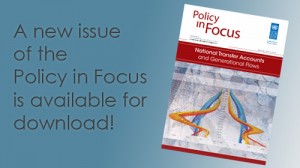Policy in Focus

Brasilia, 16 December, 2014 – The International Policy Centre for Inclusive Growth of the United Nations Development Programme has just released the latest issue of its Policy in Focus magazine, titled "National Transfer Accounts and Generational Flows." This issue examines demographic changes, intergenerational transfers, and their impacts on economic growth in several countries. It presents some of the ongoing research using National Transfer Accounts (NTA), a project that helps to understand and analyze the consequences of changes in population age distribution by estimating many aspects of economic behavior by age. As a common thread, all articles discuss the main features of the intergenerational transfers in their respective countries and make a connection between public and private intergenerational transfers and demographic change as an approach to analysing the possible impacts on economic growth.
The economic life cycle is characterised by three distinct phases: two phases of economic dependence and one phase of economic independence. In most societies, children consume resources generated by adults, transferred to them by family or by the public sector. The elderly, in turn, possess an accumulation of assets accrued during their active economic phase, and of resources produced and transferred by adults or other credit operations. Over each period of time, every society determines—by social norms, laws and individual decisions—the combination of mechanisms for resource allocation over life cycles. Intergenerational transfers represent a significant portion of the distributed production and time allocation over the life cycle and become increasingly important given the rapid demographic changes that have been happening around the world over the last decades.
The articles in this issue of Policy in Focus cover the experiences of developing and developed countries from the Americas, Africa, and Asia. The issue begins with an article by Ronald Lee and Andrew Mason on the general features of the National Transfer Accounts project that briefly discusses its main results. They show how the life cycle deficits of childhood and old age are financed in different regions and countries of the world.
Queiroz and Turra then investigate the impact of changes in population age structure on economic growth in Brazil. They show that Brazil is failing to take advantage of the positive impacts of demographic dividends. In the last few decades, the Brazilian economy has grown much more slowly than the demographic dividends alone would predict.
The following articles (on Colombia, Chile, and Mexico) deal with more specific features of intergenerational transfers. Urdinola and Tovar illustrate intergenerational transfers in Colombia and argue that elevated rates of labour market informality have negative impacts on public transfers that might undermine potential growth resulting from demographic changes.
Miller, Saad, and Holz provide an important analysis of transfers and inequality in Chile. They show how the pattern of transfers varies widely across socio-economic groups and might have impacts on the well-being of the population. Mejia-Guevara and Saucedo then discuss a specific feature of the public transfers system in Mexico: they analyse public education transfers and how they benefit children.
The remaining articles--encompassing Africa and Asia--also discuss the impacts of demographic change on economic growth. Muriithii, Mutegi and Mwabu show that Kenya can take advantage of its demographic transition if proper education and health policies are in place to increase the productivity of workers. For South Africa, Oosthuizen shows that the first half of the 70 years’ worth of potential demographic dividends has already passed, and to benefit from their potential impacts, the country should invest in policies to improve youth labour market conditions.
Regarding Asia, Narayanashows that for India that to fully benefit from demographic change, an increase in the age-specific productivity of labour, especially in the informal sector, is important to maximise the growth effects of the age structure transition. Matsukurashows that Japan, the country with the oldest age structure analysed in this publication, must start considering ways to benefit from the second demographic dividend (accumulation of wealth). He argues that the elderly population, normally seen as a liability, is in reality an important actor in the process of economic growth. To conclude the magazine, Maliki argues that, for Indonesia to fully benefit from demographic change, proper policies are needed to boost investment, improve labour market conditions, improve the accumulation of human capital and increase productivity.
